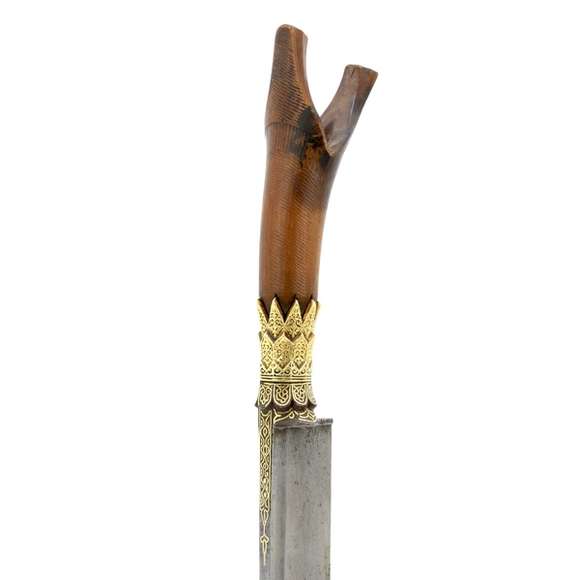Its blade with very fine and complex pamor, brought out by a polish.

Diameter 26 cm
Height 7 cm
961 grams
Brass
North Sumatra
Late 19th / early 20th century
From a Dutch private collector
Introduction
Peurise teumaga is the Sumtran term for "brass shield".1 There are two main types:
1. Thick, cast and turned brass shields with applied bosses carried to war by the noble district warlords called Ulubalangs. Several are in Dutch collections dating from the Aceh War of 1873–1904.2
2. Thinner, but more ornate shields that were used during sword dances. Most of these made their way into collections in the 20th century. They were cast by the Minangkabau of West Sumatra for the Aceh market.3
This shield is of the second type.
Notes
1. Albert G. van Zonneveld; Traditional weapons of the Indonesian archipelago. C. Zwartenkot Art Books, Leiden. Page 106.
2. G.B. Hooijer; Krijgsverrichtingen in Nederlands Indie van 1811 -1884, deel III. Pages 32-33. And John Klein Nagelvoort; Toean Stammeshaus, Leven en werken in koloniaal Atjeh. LM Publishers, 2018.
3. B. Singh; Malay Brassware: A Guide to the Collections. National Museum of Singapore, 1985.
This example
A ceremonial peurise teumaga.
Made of cast brass, the bosses and designs are all cast from the same mold. The surface of the shield is decorated with concentric lines, mimicking the lines of the turning that we see on the Ulèëbalang shields.
In the center is a large boss with an eight-pointed star around it. It is decorated with floral patterns in relief, chiseled to enhance their detail. Around the circumference of the shield are six more such bosses, somewhat smaller in size.
The inside is smooth, with four rings for the two handles that were once inside.
Comparable examples
Our shield is identical to an example in the Tropenmuseum, Amsterdam, accession number TM-2994-4. It was acquired in 1960.
Condition
No condition issues.






With a very fine Nepalese blade, but kard-like hilt and scabbard.
Early type with very shallow notch in the blade and little flare in the pommel.
20th century military khukurī with many different tools in its back pocket.






